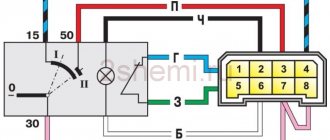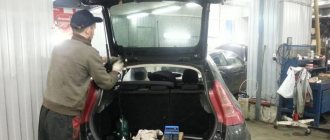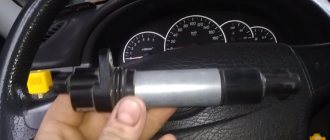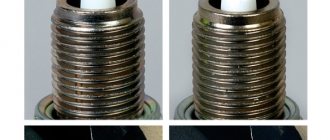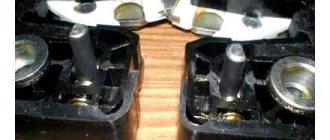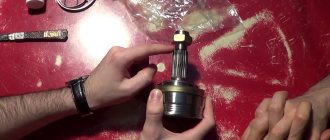Removing and disassembling the ignition switch
We remove the ignition switch to replace its assembly, as well as to replace the contact group of the switch or the APS coil.
Disconnect the wire terminal from the negative terminal of the battery. We remove the steering column switches (see “Removing the steering column switches”). The heads of the ignition switch mounting bolts are cut off. That's why.. . Unscrew them using a chisel. Loose bolts can be removed using pliers.
Remove the bracket from the steering column.
. and the ignition switch. Use a slotted screwdriver to pry up the clamp of the APS coil wire block.
. and disconnect the coil wire block from the APS block wire block.
Pressing the pad lock. ..disconnect the ignition switch contact block from the wiring harness block.
Using a Phillips screwdriver, unscrew the three screws.
. and remove the ignition switch bracket.
We take out the locking rod of the anti-theft device. Turn the key in the ignition switch.
. and remove the locking rod drive. Remove the rod spring from the drive.
. and a stopper with a spring. Push the cylinder out of the switch body.
. and remove the locking ball.
Remove the cylinder from the switch body.
We remove the locking ball spring from the hole in the cylinder.
Prying it with a screwdriver. ..we disengage the two plastic latches of the wire block cover.
. and open the lid. We mark the wires located in the block.
Using a thin awl or stiff wire, bend the locking tendrils of the wire tips.
. and remove the wires from the block.
Remove the insulating tube from the wires.
Squeeze the three plastic latches with a screwdriver. ..remove the contact group from the body.
. and bring the wires out through the holes in the housing.
Prying it with a screwdriver. . disengage the three plastic latches.
. and disconnect the contact group.
Remove the moving part of the contact group.
By pressing the moving contact and turning it counterclockwise.
. remove it from the body.
Remove the contact spring.
. remove the APS coil. We assemble and install the ignition switch in the reverse order. We install the moving part of the contact group as follows.
. so that the wide protrusion of the moving contact is located opposite the protrusion on the cover with the fixed contact. . and the protrusion on the lock cylinder should fit.
. into the recess on the body of the moving part of the contact group.
Tool:
- Multimeter
- Chisel
- Large hammer
- Narrow nose pliers
- Straight box spanner 10 mm
Parts and consumables:
- Tear-off bolts (4 pcs.)
In the power supply circuit for most of the vehicle's electrical equipment, except for the emergency, sound and light alarms, the canopy lighting, side lights, the brake signal, the security alarm and the electric door locks, voltage is supplied through the ignition switch.
To increase the car's anti-theft properties, the switch is combined with a lock, which is why this device is more often called an ignition switch. The lock body is attached to the steering column with four special bolts with break-away heads.
At a certain tightening torque, the bolt heads come off, and after that it becomes impossible to unscrew the bolts with wrenches.
The ignition switch is additionally equipped with a steering shaft locking mechanism. Once the key is removed from the lock, the spring-loaded latch is released. When you try to turn the steering wheel, the latch locks the steering shaft from turning.
Remote control power supply
The key contains a lithium battery, which is powered by 3 V. If the power supply is normal, then the diode on the key should light up for a short time when you press any button. If there are more flashes or no flashes at all, then you should change the power supply in the key. To do this, unscrew the screw, which is located on the back side of the power buttons. The halves are separated, the board is removed from the case and the battery is replaced. It is important to observe the polarity of the element. Assembly occurs in reverse order.
Design
The lock consists of mechanical and electrical parts. Briefly about the design of each of them:
- The mechanical part is a cylindrical mechanism, which can only be turned with a key designed specifically for it. In addition, this includes an anti-theft latch that prevents the steering wheel from turning.
- The electrical part consists of terminals and contacts that close accordingly with each turn of the key. For this purpose, it is connected to the lock mechanics. There are only three contacts. One of them, the thirtieth, is supplied with plus directly from the battery. The remaining two (15 and 50) are intended to turn on consumers and the starter, respectively. To limit the current through the fiftieth contact, a relay is included in its circuit. The starter is powered through its contacts, and not through the Kalina ignition switch.
The immobilizer antenna is located in the decorative ring covering the 3Z. It responds to the transponder of the key inserted into the lock. The immobilizer recognizes only its own unique signal and gives permission to the control unit to start the engine.
Where is the immobilizer located on Kalina?
The immobilizer control unit on the Lada Kalina is located deep in the instrument panel in the area of the central air duct of the microclimate system. The ring-shaped signal reader antenna is located in the ignition switch. The chip itself is mounted in the head of the key and is read automatically when the key is inserted into the lock.
Device access
To access the block you will need the following tools:
- Phillips screwdriver;
- plastic screwdriver for removing decorative elements on the panel;
- extension with universal joint and head for Phillips screws (for removing the block).
The sequence of disassembling the panel on a basic Kalina 1 without air conditioning:
- Disconnect the battery from the on-board network.
- Open the ashtray and unscrew the four screws securing the housing, remove it from the socket.
- Remove the two plugs located on the sides of the alarm button.
- Unscrew two more fastening screws that are located under the plugs.
- Remove the rotary switches for temperature and air flow direction.
- Pull the central trim towards you and remove it from the latches.
- Disconnect electrical connectors to trim-mounted components.
- Remove the standard unit, secured in a plastic case under the central air duct, using two screws.
- Disconnect the wiring plug from the unit by pressing the latch.
The photo shows the main stages of removing the immobilizer unit on a VAZ Kalina.
ZZ malfunctions
Most often, damage to the Kalina ignition switch is associated with its mechanical part. In this case, it is impossible to turn the key to the desired position. A malfunction does not arise, as they say, out of the blue. As a rule, frequent jamming of the key is observed over the course of several months, which is eliminated by rocking it in the cylinder.
Rarely, there are cases of failure of the electrical component of the Lada-Kalina ignition switch. Basically they come down to a lack of contact when turned on. This is typical only for locks with a long service life. True, there is another common reason for burnt contacts - the car owner himself.
When installing additional equipment, the owner of the car does not take into account that the maximum permissible load on contact is 15, only 19 amperes. This is quite enough for regular consumers, but the lock can no longer withstand additional light and sound devices, especially those installed at home. The contacts begin to spark and eventually fail. Therefore, when installing additional equipment, it is necessary to use an additional relay to power it.
General information about the castle
Before changing the ignition switch on Kalina, you need to familiarize yourself with the structure of this unit. It is used on VAZ 1117, 1118, and 1119 modifications. A unit is used to control the transfer of voltage to the starting system and prevent the battery from discharging.
The ignition switch here consists of several components. The kit includes the following items:
- metal case with a built-in clamp for fastening;
- mechanical block with a “secret” and a hole for keys;
- an electrical part that ensures contact closure after turning the key at a certain angle.
The designers developed this part of the car control in such a way that it functions in several modes. Let's look at them in more detail:
- zero mode allows you to effortlessly remove the keys from the hole, and when activated, the audio system, alarm system and head optics are started;
- the first position of the key is fixed and in this case it will not be possible to remove the key, since it is clamped by mechanical latches; At the same time, almost all electrical consumers are activated in it, excluding the starter;
- the second position of the key is unstable, since the driver has to hold the lock in it independently, because the position allows the starter to start.
It is important to know that it is not recommended to keep the car in the first position for a long time, as this will drain the battery.
Symptoms of a problem
The main symptoms of 3D damage are most often obvious:
- The Kalina ignition key does not turn. You should not think that it can only jam in the “0” position. Sometimes, on the contrary, the car cannot be turned off because the key does not return to the neutral position.
- A number of devices do not work, including the indicator lamps on the panel do not light up.
- The starter does not turn.
- There are constant interruptions in movement, with the disappearance of readings from control devices.
- The instrument panel lamps light up after several turns of turning the key in one direction or the other.
How to activate the immobilizer?
Kalina 1 and 2 cars are equipped with two ignition keys - black and red. The second is used to activate the immobilizer and is sometimes called the master key.
Before activation, the car owner should make sure that there are at least 10 liters of gasoline in the car’s tank. This is necessary so that the warning buzzer about the emergency fuel level does not interfere with the immobilizer settings.
- Sit behind the wheel and close the door.
- Insert the red key into the lock and activate the ignition.
- After three beeps, turn off the ignition and remove the key.
- Within 5 seconds, insert the black key and activate the ignition.
- After five (three and after a while two more) buzzer signals, turn off the ignition and remove the key.
- Within 5 seconds, install the red key and place it in the ignition switch position.
- Wait for the buzzer to sound five times and deactivate the ignition. The key must remain in the lock.
- A single buzzer will sound, after which you must turn on the ignition within 5 seconds.
- Wait another 5 seconds, after which the hazard warning lights should flash and the horn sound briefly.
- Turn off the ignition and, holding the key in the lock, wait for the immobilizer symbol on the instrument cluster to disappear.
On some vehicles, visual rather than audible indication is possible by flashing the immobilizer warning light on the instrument cluster.
The video from the avtohelpII channel shows the activation of the immobilizer on the Kalina 2 car.
Repair or buy a new one
There is no clear answer to this question. The fact is that it is very difficult to find a new contact group on the Kalina ZZ, in contrast to the classics, Samara and the tenth family. Therefore, you have to repair it, which without experience, skills and desire is not the best idea. Most often, owners install a new ZZ by purchasing it assembled.
In this case, it is necessary to take into account that the Kalina ignition switch has an immobilizer that will not respond to the new key and the car will not be able to start. Of course there is a way out. You can retrain the immobilizer for a new key. In this case, you will also have to change the cylinders on the door locks.
You can do it easier - carry two keys with you. True, it is not clear whether it is worth keeping them on one bundle. Therefore, the most reasonable thing would be to make a new “tip” and install it on the old key. By the way, it may be included in the delivery of a new lock.
The purpose of the key and its capabilities
The remote control for a car is designed to remotely open and lock doors, turn on the alarm, block the trunk door, lower the windows and perform other actions. This key is also used as a coded electronic key for the immobilizer. The immobilizer can be disabled, then the car will be able to start from a “normal blank”.
Such a system is attached to the metal part of the key itself and is intended for connection to the car system by:
- Radio channel.
- Transponder channel.
Correct use of the key
Regular remote control key Lada Kalina
To use the remote control key in a car, it must first be trained (activated). To do this you need to use a training key. Also, using such a key, you can remove restrictions on starting the engine. It is possible to use such a key with two remote controls.
Replacing the ignition switch
As always, if the work involves electricity, you need to start by disconnecting the negative terminal of the battery. The tool you will need is a shaped screwdriver and a small chisel. You must purchase an ignition switch in advance. In this case, you need to take into account the presence of an immobilizer. If everything is ready, you can proceed to replacement. The sequence of actions is as follows:
- After unscrewing the five bolts, remove the decorative steering column cover. The screws are different, so it’s better to remember which one was placed where. In addition, to remove the casing, you need to lower the steering column adjustment knob.
- The ignition switch is secured to two clamps, secured with bolts that cannot be unscrewed with a key. Therefore, you will have to use a chisel. You need to rest it against the cap and unscrew it with careful but rather strong blows until it becomes possible to do it with your hands. That is, you should not cut off the bolt with a chisel, but use it as an analogue of a key.
- Thus, you will have to unscrew all 4 screws.
- The lock will remain hanging on the wires.
- We disconnect the electrical connectors, and the ignition switch can be easily removed.
- Installation is carried out in reverse order.
It is worth noting that this sequence of actions is similar for all modifications of the car, including the ignition switch of the Kalina 2, produced since 2013.
If the problem is the spark plugs
It is not always the case that the Kalina engine does not start due to problems with the ignition switch. You can start looking for problems with the spark plugs. What kind of candles are required for Kalina? Products A17DVRM are recommended. They can be replaced with A15DVRM. These domestically produced spark plugs can be replaced with imported analogues. Their brand largely depends on the engine:
Engine with 8 cl. Engine with 16 cl. А17ДВРМ АУ17ДВРМ 14R-7DU 14FR-7DU RN9YC RC9YC BPR6ES BCPR6EC W20EPR Q20PR-U11 LR15YC DR15YC WR7DC FR7DCU. Spark plugs have different prices in different regions of the country. A set of them costs approximately from 200 to 500 rubles.
Spark plugs from some manufacturers may have a different number of electrodes. Along with standard single-electrode spark plugs, there are multi-electrode spark plugs. For cars manufactured by VAZ Kalina, standard single-electrode spark plugs are recommended. Their service life depends on the conditions in which the vehicle is operated.
It is recommended to change spark plugs every 30,000 km. Many owners of Lada Kalina cars identify the following spark plugs as the best brands: Brisk, Denso, NGK. A fairly significant group of car enthusiasts highlights the A17DVRM spark plugs produced in Engels. To replace spark plugs on Kalina you need a special spark plug wrench. The procedure is quite simple.
- The engine in the area where these products are located must be wiped clean so that debris cannot get inside the cylinders when the spark plugs are unscrewed.
- The tight-fitting wires are removed from each spark plug one by one.
- The candles are turned out and inspected (image No. 4).
- The candles are first screwed in by hand, then tightened with a wrench.
The ignition switch in a car is a reliable unit that can operate for a long time and without failure. But sometimes it has to be removed for repairs or for complete replacement. You can do this yourself. At the same time, you can check the functionality of parts that may fail.
The causes of engine problems may be hidden in the malfunction of other components and mechanisms of the car. These include spark plugs, ignition coil and ignition module. An automotive electrician will professionally handle the search for such causes.
